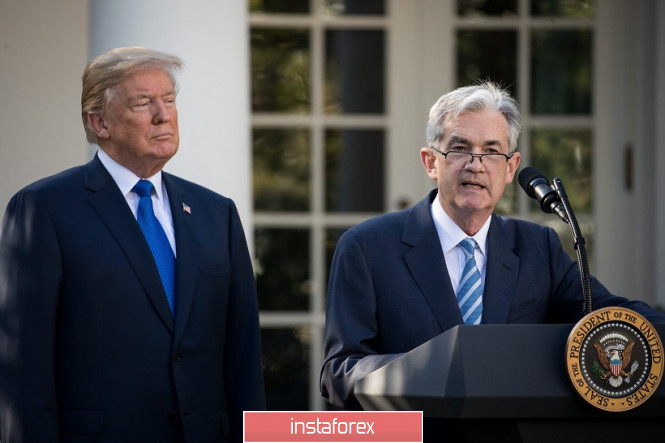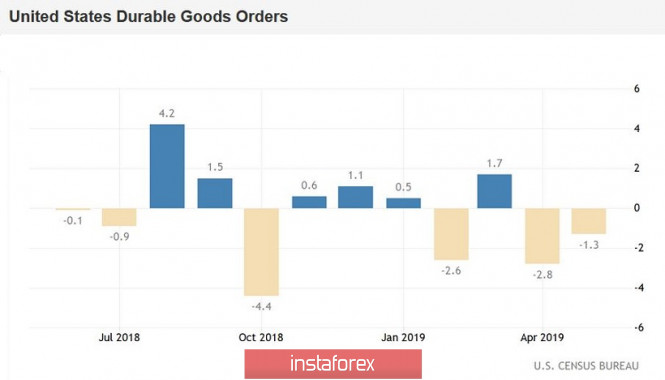The dollar bulls did not take the time to be inspired by the neutral comments of the Fed head, as the dollar again came under pressure from fundamental factors. At this time, the focus of traders was the president of the United States, Donald Trump, who again criticized the actions of the Fed and once again threatened to remove the head of the American regulator.
On the other hand, the market has become accustomed to similar rhetoric of the US President. Trump has been actively criticizing the Fed for the past year, expressing dissatisfaction with the tightening of monetary policy conditions. Today, Trump even offered to "exchange" Powell for Draghi - according to him, while the ECB is pouring money into the economy, the Fed "pulls it out of it" like a vacuum cleaner.
I will note that during the period of his presidential term, Trump dismissed from the White House quite a few officials, advisers and specialists. According to experts, staffing "turnover" with him is the most active compared to the rest of the US presidents. And without any doubt, we can assume that Trump would have dismissed the current head of the Fed a year ago, if this issue got resolved with one stroke of his pen. But the thing is, Powell is not Trump's subordinate. The President of the United States selects applicants for this position, conducts interviews, introduces a candidate to Congress and lobbies the "chosen one" with his influence. But then their paths diverge: formally, the US Central Bank is an independent body, whose activities are not controlled by the executive branch. For example, Mick Malwyny,

Today, Trump stated the opposite. According to him, he can remove Powell from office and has the appropriate authority to do so. In fact, this is quite a controversial issue. Contrary to popular belief about the full "immunity" of members of the regulator, the head of the American state has the authority to dismiss any Fed governor, although this provision has not yet been applied in practice. The core law "On the Federal Reserve" literally reads as follows: "... each member of the regulator occupies his post for a period of fourteen years from the date of the expiration of the term of office of his predecessor, unless he is fired by the President for anything else he did before. And although this formulation allows it to be interpreted widely enough, the fact remains: the President of the United States has the authority to dismiss the head of the Fed.
According to experts, the head of state can really remove Powell from his post, but only if he violates the law. In addition, the Congress will have to get "reinforced concrete arguments" in order to remove him from office by voting and by the appropriate procedure. Obviously, Trump's disagreement with the Fed's ongoing policy is not consistent with the above algorithm, so this scenario will most likely not be implemented. Donald Trump in his usual manner mentioned such an opportunity. But here, it is necessary to take into account, firstly, his impulsiveness, and secondly, the fact that he said this after doubts voiced by Powell that the regulator needs to lower the interest rate at the next meeting.
Thus, despite the absence of indisputable powers of the President of the United States in the sphere of the removal / dismissal of the head of the Fed, the dollar still came under certain pressure. Donald Trump is clearly putting political pressure on the Fed, demanding monetary easing. The head of the Fed, in turn, at every opportunity, recalls that the Central Bank is an independent body whose members make decisions based on economic factors rather than political ones. And yet, after a series of corresponding statements by Trump last year, the Fed really halted the rate hike cycle, and after a few months, regulators spoke about the need for accommodation of monetary policy. Whether or not this is a match is an open question.
Here it should also be noted that there have been recently appeared arguments in favor of lowering the interest rate without the political intervention of the White House. Key and secondary macroeconomic indicators show a slowdown in response to trade tensions between the United States and China. In particular, the latest published releases were not in favor of the dollar. For example, the indicator of consumer confidence of Americans collapsed to two-year lows, and the volume of orders for durable goods disappointed traders negative dynamics. The indicator remained in the negative area (-1.3%), thus continuing the April trend.

Thus, the overall fundamental picture did not allow the dollar to "spread its wings". Although yesterday had "moderate optimism", Powell was quite conducive to the realization of this scenario. In turn, eur / usd buyers also could not lead the pair away from local minima: the pair updated the high of the day, but that's where the northern impulse has exhausted itself. The eur / usd pair is still trading in the range of 1.1295-1.1420 (respectively, the Tenkan-sen line and the top line of the Bollinger Bands indicator on the daily chart) and, apparently, will trade in this price range until the most significant event of this week - the G20 summit.
The material has been provided by InstaForex Company - www.instaforex.com